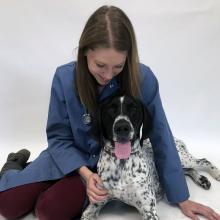My fourth week at Picton Animal Hospital is over, I can’t believe that I’m already halfway through! Here are the answers to the cytology quiz in my Happy Long Weekend blog.
The little purple footprints you see in this picture on the left are a yeast called Malassezia. Malassezia is not part of the normal flora in dogs’ ears, so if it comes up on a swab, the yeast infection should always be treated.
.JPG)
.JPG)
Now that it’s allergy season in people, it’s “heaves” season in horses. Heaves, also known as “recurrent airway obstruction”, “COPD” or “equine asthma”, is a chronic, progressive disease. Heaves is not fully understood, but it is thought to start out as some combination of a respiratory infection, allergy, and autoimmune condition, and becomes a chronic inflammatory condition over time.
At PAH, we see a phenomenon where, across the entire county, all of our chronic heaves patients have their first flareup of the season within the same week, typically around the beginning of May. When that week hits, the phones start ringing, and it’s time to try out different combinations of steroids and bronchodilators to keep each patient breathing as easily as possible until the cooler months roll back around.
I’ve had the opportunity this week to start talking to clients about dog training, one of my favourite hobbies outside of the classroom. Training has an important role in veterinary medicine, although I don’t think it always gets enough emphasis. The ways in which we interact with our pets on a daily basis have a huge impact on our bond with them, and a huge impact on rates of animal relinquishment. Veterinarians can be an important resource if someone is struggling with a particular behaviour, or even for clients with a new puppy or kitten. Not only can we sometimes discover a medical cause for a behaviour (especially peeing in the house!), but we can provide resources for training, such as good books and websites, recommendations about dog trainers in the area, and we can even sometimes suggest an appropriate medication to help decrease a pet’s stress or anxiety, so that training can progress more quickly.
I’ll leave you today with a video of Talia, a nine-week-old English Springer Spaniel puppy who is learning how to use her new Kong Wobbler toy. These days, there are tons of interactive feeding toys available for both dogs and cats. They are great for helping our pets become more confident, they can provide mental stimulation during inclement weather, and they are a great tool for assisting in a pet’s weight loss journey (if dinner suddenly lasts thirty minutes instead of thirty seconds, what dog or cat is going to notice that they got less kibble?)!
